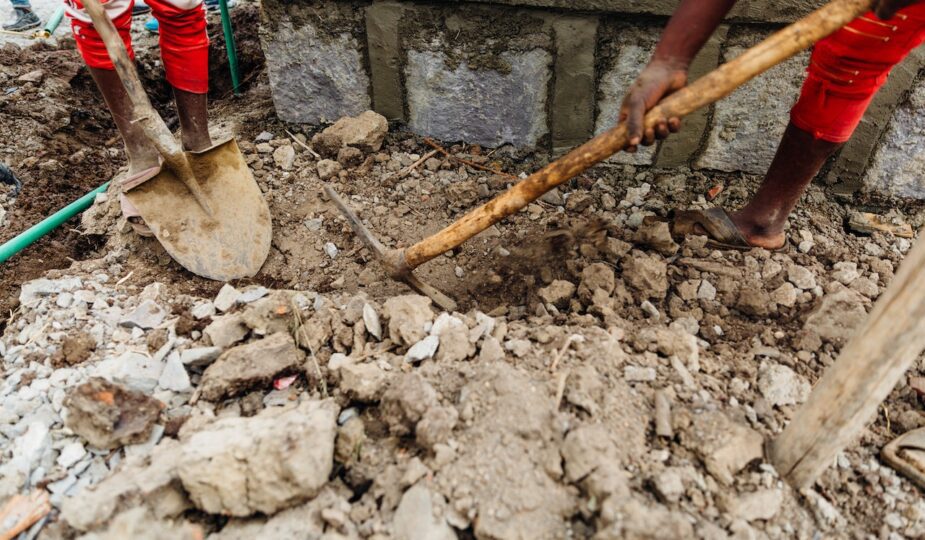A French drain is an effective solution for drainage issues such as soggy lawns, water pooling near the home, or basement flooding.
Digging the Trench
Contents
The most labor-intensive part of any French drain installation in Staten Island is digging the trench. Whether you explore the track yourself or hire a professional, make sure to call 811 (the national or state hotline) to have buried utilities marked before starting your project. Not only is this the law, but it will keep you from cutting into power lines or other vital infrastructure that could cost you hundreds of dollars in repairs or even a fine.
Once you’ve marked the area for your trench, decide on a drainage route for excess water. Channeling it away from your house and avoiding fences, walls, posts, and shrubs will reduce the risk of damage to the French drain or problems with neighbors’ landscaping. It’s also important to establish if you need a permit and whether your local municipality has any restrictions for draining water into the street.
Depending on the type of pipe you choose—rigid PVC is more expensive but won’t get clogged by tree roots and requires no gluing—you may need to trench a few inches deeper than what will be your final grade. This will allow the pipe to be covered with gravel, landscape fabric, and topsoil. Concealing the pipe will be easier on future maintenance efforts and give your yard a more natural look.
Selecting the Pipe
You can find a wide selection of drain pipes at your local hardware store, including perforated corrugated pipe with aggregate mesh and even a pipe already encased in fabric. These French drain alternatives are flexible and easy to work with but may not be as durable as a standard PVC French drain.
Regardless of the drain type, ensure it has enough holes to allow water flow without clogging. It would help if you also looked for a pipe that’s easy to install. Corrugated pipe fittings snap on, reducing pipe primer and solvent needs. Likewise, some French drain kits include pre-made pipe sections with all the necessary connectors and are ready to install.
Once you’ve selected your pipe, determine how the drainage path should run through your yard. It should be channeled away from your home, toward a municipal storm drain, or into a rain garden, where the soil can absorb and hold the water. Be sure the path is free of obstacles like walls, fences, posts, trees, and shrubs.
If you are worried about the complexity of your project, consider hiring a professional installer. They will have the experience and equipment to ensure your French drain is installed correctly and will last for years. Just remember that hiring a pro will cost more upfront but can save you money in the long run.
Filling the Trench
French drains can effectively divert excess water from your yard and help protect your home’s foundation. However, installing a French drain is often labor-intensive and requires digging a large trench on your property. This can interfere with landscaping and cause trees, plants, and grassroots issues. For this reason, homeowners may consider hiring a professional.
Creating a French drain involves digging a trench and placing a perforated pipe in the bottom. The drain is then covered with gravel to help it function properly. Gravel is usually chosen because it provides a sturdy base that can support the weight of the pipe and prevent clogs. The type of gravel used can vary, but a combination of coarse sand and crushed stone works well.
During this step, it is important to ensure the trench slopes correctly. The trench should slope by at least one percent, or an inch, for every 10 feet. The drain should also be placed perfectly to direct water away from homes and structures.
Before beginning the project, it is important to call 811 to have your utility lines marked. This will minimize the risk of accidentally damaging a line and incurring costly repair fees. The next step is to fill the trench with gravel or crushed stone, covering the entire drain pipe. After that, the remaining trench is filled with native soil to complete the installation.
Planting the Drain
You can install a French drain yourself, but this project is labor-intensive. It would help if you dug a trench, laid down the pipe, and covered it with gravel. If you want to save time and energy, consider hiring a professional to install your drainage solution.
Before you begin your French drain installation, it’s important to contact the local utility company to have any underground lines marked. This ensures you don’t accidentally hit a line during the digging process.
Next, choose a slightly downward-sloping area of your yard, at least a few feet away from any walls or fences. Ensure the site is free of rocks, posts, or shrubs. Once you’ve chosen your spot, lay the perforated drainage pipe with its holes facing down. This will help keep the gravel from clogging the pipe and allow water to enter the drain more easily.
Once the drain is in place, cover it with a layer of gravel to conceal it. This is optional but a good way to help your drainage solution look more natural and blend into your landscape.
You can also add a catchment barrel at the terminus of your French drain to collect rainwater for later use or to help filter out contaminants before it reaches the waterways. Ultimately, installing a French drain is a great way to improve the appearance of your landscape and protect your home from costly water damage.








